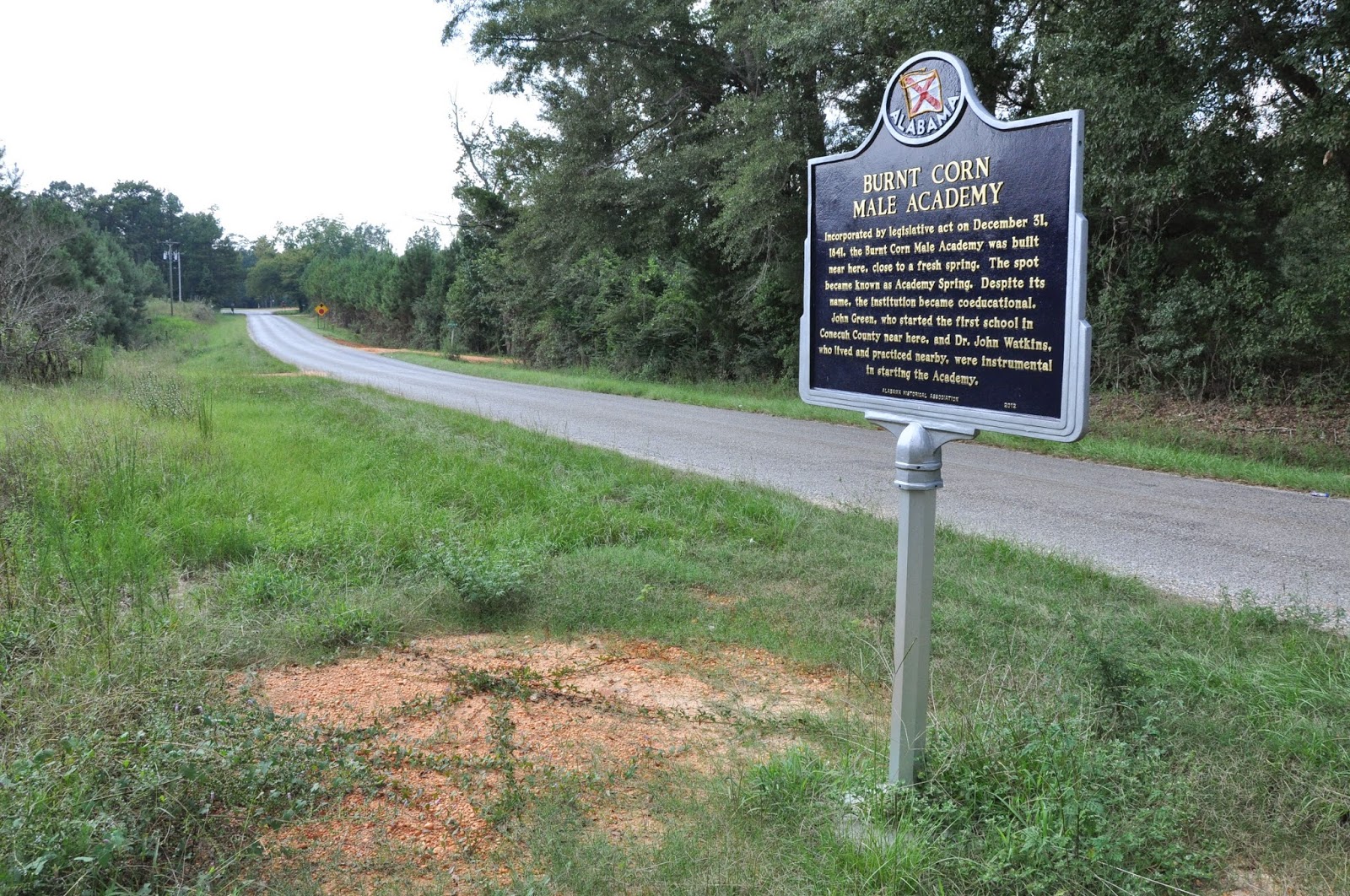| BURNT CORN, ALABAMA | ||

BURNT CORN MALE ACADEMY
The Burnt Corn Academy was located about two hundred yards to the right of the Old Federal Road at Burnt Corn going north. The Academy's location probably chosen because of a good spring being in this spot. This spring was known as the Academy Spring. Later, this area became a pasture and a nergo cabin occupied by "Uncle Bob Betts" (a slave) was there for many years. The Academy was in the neighborhood of the Fountians, Clingmans, and O'Brien, his wife Nannie Clingman O'Brien, and their daughters, Bettie Lanier O'Brien were teachers in the Academy. Mr. O'Brien was the principal or headmaster. There are no signs of any od these building now, but the spring is probably bubbling on and waiting for children with their buckets and gourds.
On December 31, 1841, the Burnt Corn Academy was incorporated by the Alabama legislature in the following words: "That a Male Academy be and same is hereby incorporated in the County of Conecuh, to be styled and known in law, as the Burnt Corn Male Academy, and that John Watkins, John Green, John Marshall, J.J. Roach, T.S. Roach, J.B. Clausel, Ithiel Lee, Hanson Lee, John R. Richardson, Caleb Lindsey. William E. Ellis, William Cunningham, Anaias Godbold, Eli Atkinson, and Issac Betts, and their successors in office be, and they are hereby declared a body politic and corporate, by the name and style of the Burnt Corn Male Academy; as such shall be capable in law or equity to sue or be sued, and plead and be impleaded, and shall be deemed necessary and expedient for the good good government of said academy, and for that purpose may have and use a common seal, and alter the same; appoint such officers as they may deem proper, and remove the same for improper or neglect of duty. Provided, such by law and regulations as are herein authorized to be made, be not repugnant to the laws and constitution of this State and of the United States."
It is believed that both boys and girls attended this academy, even though at first males only were permitted.
BURNT CORN MALE ACADEMY The Burnt Corn Academy was located about two hundred yards to the right of the Old Federal Road at Burnt Corn going north. The Academy's location probably chosen because of a good spring being in this spot. This spring was known as the Academy Spring. Later, this area became a pasture and a nergo cabin occupied by "Uncle Bob Betts" (a slave) was there for many years. The Academy was in the neighborhood of the Fountains, Clingmans, and O'Brien, his wife Nannie Clingman O'Brien, and their daughters, Bettie Lanier O'Brien were teachers in the Academy. Mr. O'Brien was the principal or headmaster. There are no signs of any of these building now, but the spring is probably bubbling on and waiting for children with their buckets and gourds. On December 31, 1841, the Burnt Corn Academy was incorporated by the Alabama legislature. It is believed that both boys and girls attended this academy, even though at first males only were permitted.
BURNT CORN FIRST PUBLIC SCHOOL
The children in this photo starting with the front row, left to right: Glenn Higdon, Gladys Waters, Sonny Mines, Evelyn McMillan, J.L. Crawford, Crawford King, Paul Fortner, Fred Wells,
Ray Waters, Melva Andrews, Hestle Day: second row: Alice Crawford, Lilburn Shofner, Prudence Smith, Bertha Higdon, Edna Green, Burgess Waters, Bobby Brantley, Billy Brantley, Eugenia Ellis,
Pat Morrison; third row: Mildred Morrison, Edith Hightower, Ann Caines, Elose Waters, Kathleen McMillan, Ruby Day, Dorothy Crook, alvin Salter, Eugene Shofer, Fred Shonfer,Jr., Curtis
Andress, Charles Gilmore, Bennie Whistenhunt; back row: Miss Addie Rumbley, Ima Jean Brantley, and Minnie Howard Morrison.
The first public school taught in Conecuh County was in the vicinity of Burnt Corn and was taught by John Green, Sr. Some say this school was known as "Student's Retreat." Later there was a school in the Burnt Corn vicinity known as "Oak Villa School." It believes that school was located near Puryearville Church. Much later there were at least two schools for negro children in the Burnt Corn area. One was located in New Hope area of Burnt Corn called "Buttrick School" New Hope Roasenwald School near the New Hope AME church.